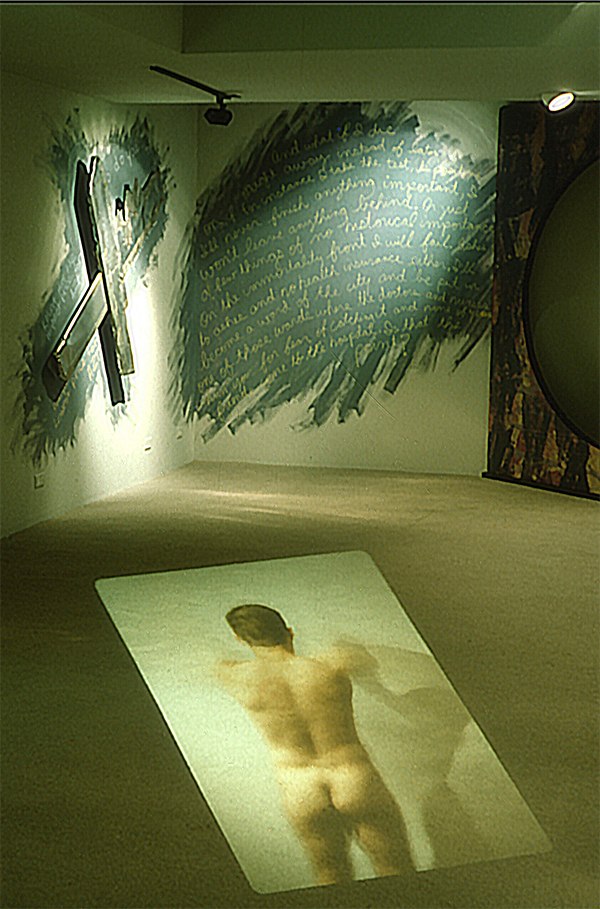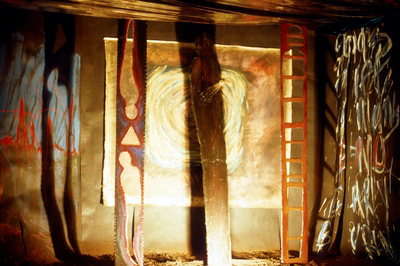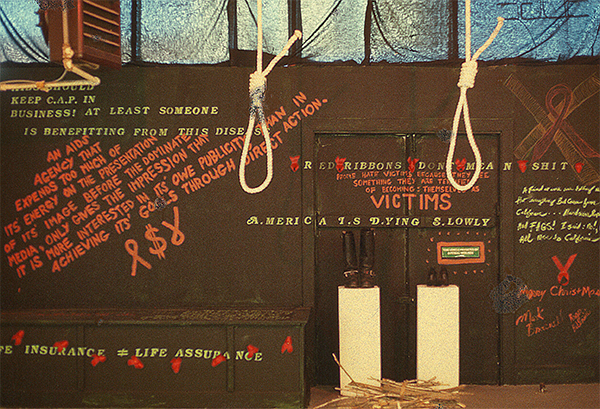April 15, 2021
Conceptual Artist Mark Brasuell discusses his Art and Activism in Colorado during the AIDS epidemic
On Wednesday, April 21, MCA Denver will host a conversation on AIDS & Activism as part of the free, virtual programming for our Keith Haring: Grace House Mural exhibition. Keith Haring often used his art as a means of activism to increase awareness of the AIDS epidemic in the ’80s. He was involved in groups like ACT UP, which were formed to bring awareness to the devastating virus that, at the time, was mostly affecting gay men, yet, was receiving little attention or funding for research from the government. Around the country, chapters of ACT UP were formed, but individuals also took to the streets themselves in protest and found ways to bring direct attention to the epidemic.
Mark Brasuell is a Denver-based conceptual abstractionist artist and activist who used art to speak out about the AIDS crisis and its impact on the gay community. Through email conversations and a Zoom chat, I was able to hear Mark's story, and learn more about Denver's response to the epidemic in the ’80s, as well as how he used his art to speak out and bring awareness to this devastating virus.
Hi Mark! How are you doing?
I am doing well in this pandemic world. I am currently working on my art in my studio in Green Valley Ranch, here in Denver. I am working on a body of work based on an eraser: I am using the eraser to remove and also inform the artwork. I think in society today that we are constantly erasing stuff (ideas, people, politics). It is the form of censure that I am very interested in. Why do we keep stuff and why do we choose to erase something. I think the Keith Haring show is a great example of this. His work was saved, and often, especially with graffiti, it is destroyed. That symbiotic relationship is what I am interested in right now.
We are currently exhibiting Keith Haring: Grace House Mural at the museum. Haring used art as a form of speaking out, especially in the 80s with the AIDS epidemic and with other social crises like the crack epidemic. In Haring’s use of art as a tool for social change, can you talk about your philosophy on or experience with using art to bring awareness to social issues?
My entire career has been about informing people. Very early on in my artistic career, I was political. Because my art is about me, about my life, about the world around me, and about what I can do about it, I was pegged early on as too eager to share my opinion in art. That scared off many galleries that were afraid to show political or personal art. I famously had a commercial gallery tell me they were afraid to show my work as they “didn't know what I would do.”
I think art is about life, and sometimes that life is about horror. When I came out, the AIDS epidemic was surging. I embraced the challenges that arose and spoke out through my art, creating work that confronted the President at the time (Reagan, who didn't even say the word AIDS for many years). Like Haring, Larry Kramer [founder of ACT UP], and David Wojnarowicz [artist and AIDS activist], I spoke out with my art. I challenged the church with a piece about the Pope (a sculpture of a shovel with the words, “the Kingdom of Heaven open to everyone,* 'does not apply to people with AIDS.'” I have made artwork about Jesse Helms, Pat Buchanan, and Magic Johnson. I created a work with Dan Thigpen, titled “Know your Enemy,” with thousands of names of people that are enemies of gay people. Art is a vehicle to mirror society and bring understanding to causes and people that are being erased.

What was the attention to the AIDS crisis like in Colorado in the 80s?
Very scary! Attention was only given when we shoved it in the public's face, through both public protest, and through art. People are often divided: There were a ton of people that wanted to ignore AIDS and there were also many that took to the streets and were very vocal about it. People were dying. My friends were dying. Many friends that I had, had such a great attitude about it. Of course, they were crushed but determined to beat this. Before the “cocktail” of meds, I have over 10 of my friends die in one year. Larry Kramer's famous plague speech was a huge inspiration to me (Larry Kramer from “How to Survive A Plague ). He was pissed, and I was too. I felt like people thought we were expendable, and I wasn't going to let that happen. Over 42 million have died from AIDS. 42 MILLION!
You created multiple works focused on AIDS and the tremendous loss of life due to the epidemic. Were galleries and/or museums receptive to showing your work and the context of your work? In your teaching today, how do you encourage the importance of speaking out in aspects of social awareness to your students?
Now more than ever, students are aware. Probably more than I ever was. Change is happening both with students and with younger people to change the bullshit we have seen over my many years. Finally, people are getting some motion with racism, classism, and with sexism. My main focus has been, “If you don't say something, who will?” I do that with assignments based on sex, politics, and even religion. People are finally discussing it with a bit of perspective. My religion assignment was simple: Investigate a religion that is not yours and make an artwork about it. Every time, I am met with resistance as people are afraid to research something and find out something they didn't know about it. I want people to explore and challenge, you are not given that many chances to do that; and school, education, and college are seen to be the last places to do that.


In 1992, there was a ballot initiative, Amendment 2, passed by Colorado voters that prohibited the state from enacting anti-discrimination protections for gays, lesbians, and bisexuals. The ballot was eventually deemed unconstitutional by the Supreme Court in 1996 and overturned but not before Colorado became known as "the hate state." What was your experience like in bringing attention to/fighting this egregious initiative?
I was very active with this. My second abstract show at EDGE Gallery was called “2,” and I used the language from the dissent opinion as subject matter for the works. The dissent was written by Antonin Scalia and included sayings such as, “homosexuality is morally wrong,” and basically that people had the right to discriminate against gay people.
These were bold and colorful paintings but also showed the hatred against gay people by straight people. I organized the first art auction to raise money for the political fight to reverse Amendment 2. When we made flyers and mailers, someone at the post office refused to give us stamps because they agreed with Amendment 2. Fighting bigotry was a big deal for me, and we faced it with a vengeance. Eventually, Amendment 2 was overturned.
I know that your friend, Roger Beltrami, was a part of ACT UP – Colorado, but you both were members of EDGE gallery. Could you share what inspired the creation of the co-op contemporary space?
The alternative cooperative scene in Denver is one of the biggest in the U.S.A.. EDGE was founded on the idea that commercial galleries would not show the work that we were doing and that some of our work was too radical for the contemporary art world, so we built a subculture to show our work in all its rawness and outrageousness. We had a huge following and were at the forefront of many movements. Roger joined after me and we became quick friends. I saw his work at a gay bar called Garbo's in the 90s.
Not afraid to talk about AIDS and the organizations at the time, we teamed up for an installation called “Something about Two Fags,” an installation with inverted AIDS ribbons that looked like nooses and political sayings on the walls. In front was a pair of high heels, pair of combat boots, and two bundles of sticks (“fags” in archaic use). I remember that someone from CU Boulder (who taught gay studies and wasn't gay) criticized us for calling out the Colorado Aids Project. I told him that we have the right to point out injustices and we were not afraid of criticism. Roger eventually died from complications due to AIDS and his last showing at EDGE was a group of Crows watching a nest full of eggs plastered with the list of interactions of an AIDS drug Roger was taking. Even in the end, Roger was shouting to everyone, look at us, look at what is happening to us. I spoke at his eulogy and said goodbye to another yet friend.

As an art professor at Naropa University, how do you approach teaching about social awareness and the importance of speaking out against oppression and injustices to your students?
I am very vocal about it. I have lectures about art during the time of AIDS, and Keith Haring shows up there. I talk about the idea that art is used to engage, to involve people, and to enlighten. Art is political, and even when it is a minimal white painting, it is speaking volumes. I have taught for over 30 years, and there are many students who want to express that themselves. Sometimes they will say I just want to say “fuck it.” I tell them, shout it, write it, paint it. Visceral feelings are there for a reason and need to be expressed. I have several classes on sexism, homophobia, and racism - I do not shy away from these important topics.
What are you hopeful for in 2021?
I think there is a lot to be hopeful for. A new president, a new openness to policies. We have a transgender representative in government. That is a big wow. I have been a long-time advocate of trans rights and this is a big one. I am ready to see us move to be more visible as gay artists, people, and communities. Last year I helped create one of the first shows to feature gay artists in Colorado at the McNichols event center. Hopefully, this will lead to a full-blown examination of gay culture in Colorado, across all the letters of LGBTQ+.